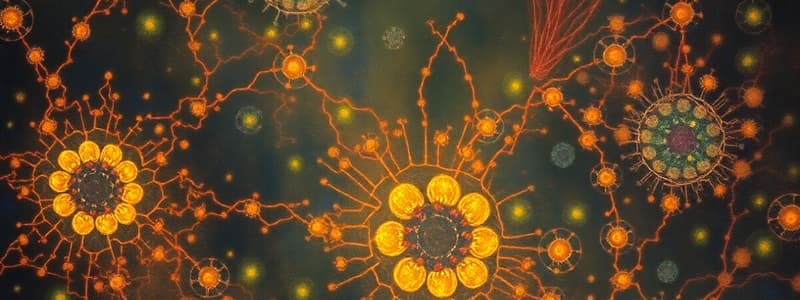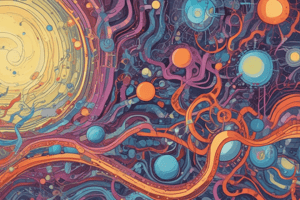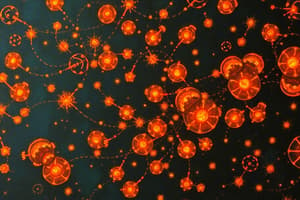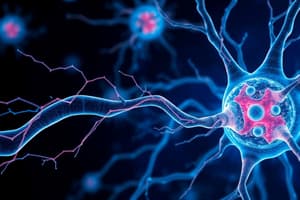Podcast
Questions and Answers
What is the simplest explanation of cell signaling?
What is the simplest explanation of cell signaling?
Ligand binding to a receptor, which causes a response.
Which of the major categories of transmembrane receptors involves GDP being converted to GTP as part of the signal?
Which of the major categories of transmembrane receptors involves GDP being converted to GTP as part of the signal?
- Receptor Tyrosine Kinases
- Steroid Receptors
- Ion Channel Receptors
- G-Protein Coupled Receptor (GPCR) (correct)
Which of the following is NOT a characteristic of homologous chromosomes?
Which of the following is NOT a characteristic of homologous chromosomes?
- They are similar in size and shape.
- They have the same genes in the same order.
- They have different alleles.
- They are genetically identical. (correct)
The cell spends most of its time in M-phase of the cell cycle.
The cell spends most of its time in M-phase of the cell cycle.
Which of the following is NOT a mechanism of gene regulation in prokaryotes?
Which of the following is NOT a mechanism of gene regulation in prokaryotes?
Which of the following processes does not use a proton gradient to produce ATP?
Which of the following processes does not use a proton gradient to produce ATP?
The primary purpose of fermentation is to produce ATP.
The primary purpose of fermentation is to produce ATP.
What is the key component of the plasma membrane that allows water molecules to pass through the membrane?
What is the key component of the plasma membrane that allows water molecules to pass through the membrane?
Match the following molecules with their chemical groups:
Match the following molecules with their chemical groups:
What is the name of the enzyme that unwinds the DNA double helix during replication?
What is the name of the enzyme that unwinds the DNA double helix during replication?
What does primase do?
What does primase do?
What are the 3 stages of transcription?
What are the 3 stages of transcription?
The prokaryotic trp operon is an example of an inducible operon.
The prokaryotic trp operon is an example of an inducible operon.
What is the name of the enzyme that breaks down lactose?
What is the name of the enzyme that breaks down lactose?
Histone acetylation leads to a decrease in chromatin condensation.
Histone acetylation leads to a decrease in chromatin condensation.
Flashcards
Cell Signaling
Cell Signaling
Communication between cells, often involving a ligand binding to a receptor, triggering a cellular response.
Signal Transduction
Signal Transduction
The process by which a cell receives and relays a signal within its internal environment.
Autocrine Signaling
Autocrine Signaling
A type of local signaling where a cell targets itself.
Direct Contact Signaling
Direct Contact Signaling
Signup and view all the flashcards
Gap Junctions
Gap Junctions
Signup and view all the flashcards
Plasmodesmata
Plasmodesmata
Signup and view all the flashcards
Paracrine Signaling
Paracrine Signaling
Signup and view all the flashcards
Endocrine Signaling
Endocrine Signaling
Signup and view all the flashcards
Synaptic Signaling
Synaptic Signaling
Signup and view all the flashcards
G-protein Coupled Receptors (GPCRs)
G-protein Coupled Receptors (GPCRs)
Signup and view all the flashcards
Receptor Tyrosine Kinases (RTKs)
Receptor Tyrosine Kinases (RTKs)
Signup and view all the flashcards
Ligand-gated Ion Channels
Ligand-gated Ion Channels
Signup and view all the flashcards
Steroid Receptors
Steroid Receptors
Signup and view all the flashcards
Phosphorylation
Phosphorylation
Signup and view all the flashcards
Dephosphorylation
Dephosphorylation
Signup and view all the flashcards
Second Messengers
Second Messengers
Signup and view all the flashcards
Signal Specificity
Signal Specificity
Signup and view all the flashcards
Signal Amplification
Signal Amplification
Signup and view all the flashcards
Signal Diversity
Signal Diversity
Signup and view all the flashcards
Chromatin
Chromatin
Signup and view all the flashcards
Chromosomes
Chromosomes
Signup and view all the flashcards
Chromatid
Chromatid
Signup and view all the flashcards
Sister Chromatids
Sister Chromatids
Signup and view all the flashcards
Interphase
Interphase
Signup and view all the flashcards
Mitosis
Mitosis
Signup and view all the flashcards
Cytokinesis
Cytokinesis
Signup and view all the flashcards
Diploid (2n)
Diploid (2n)
Signup and view all the flashcards
Haploid (n)
Haploid (n)
Signup and view all the flashcards
Homologous Chromosomes
Homologous Chromosomes
Signup and view all the flashcards
Meiosis
Meiosis
Signup and view all the flashcards
Crossing Over
Crossing Over
Signup and view all the flashcards
Independent Assortment
Independent Assortment
Signup and view all the flashcards
Study Notes
Exam Review
- Review is recorded on Sunday, Dec 8th, 2024
- Slides will also be posted.
Exam Information
- Exam date: Friday, December 13th at 10:30 AM CST
- Exam duration: 75 minutes (officially closes at 3 pm)
- Exam location: On Canvas under the "Quizzes" tab, same as previous exams.
- Exam format: ALL multiple choice questions; no free-response questions (FRQs).
- Content breakdown: 50% of the content from Weeks 12, 13, and 14, and 50% of the content from Weeks 1–11.
- Exam points: 106 points (21.2% of total grade)
- Number of questions: 53; each worth 2 points.
Content Review by Weeks
- "Unit 4": Weeks 12, 13, 14
- Unit 1: Weeks 1–4
- Unit 2: Weeks 5–8
- Unit 3: Weeks 9–11
Week 12: Cell Communication and Signaling
- Cell signaling: ligand binding to a receptor, resulting in a cellular response
- Signal transduction: processes involved in signal transmission within the cell
Cellular Messaging
- Cellular signaling pathways
- Different stages of a signal transduction pathway
- Ligand binding to receptor
- Receptor activation of a protein at the membrane
- Activation of protein in cytosol
- Activation of a target protein within cell that triggers response
Local Signaling
- Autocrine signaling: cell targets itself
- Direct contact: through cell junctions, such as gap junctions(animal) and plasmodesmata(plants/algae).
- Paracrine signaling: cell targets nearby cells
Long Distance Signaling
- Endocrine signaling: animals use hormones that travel through the bloodstream to target cells in remote locations.
- The message (hormone) binds to specific receptors to carry out the response.
Synaptic Signaling
- Neurotransmitters (chemical messages) converted to electrical signals in neurons.
- Movement of signal from outside of the cell (high Na+ and Cl-) to the inside of the cell (high K+), which creates a response.
- Influx of Ca2+ releases neurotransmitters to pass signal onto the next neuron
- Signal received by neurons creates a cellular response
3 Stages of Cell Signaling
- Reception: binding of signal molecule to receptor causing conformational change.
- Transduction: relaying the message via activation of enzymes. Cascades of protein activation in signal transduction pathway which also causes the shape of each protein to change.
- Response: activation of cellular response
Receptors
- G-protein coupled receptors: ligand binding converts GDP to GTP.
- Receptor tyrosine kinases: 2 signaling molecules binds to 2 receptors creating a dimer, and activating intracellular relay proteins.
- Ion channel receptors: signaling molecule binds to receptor, triggering ion movement.
- Steroid receptors (Intracellular): steroid hormones cross the membrane and interact with these intracellular receptors.
- Some can directly bind to DNA.
Transduction: Phosphorylation/Dephosphorylation
- Phosphorylation: Adding phosphate group through kinase.
- Dephosphorylation: Removing phosphate group through phosphatase. Phosphorylation cascade involves multiple relays of phosphorylation by protein kinases.
Transduction: Second Messengers
- Small, non-protein molecules that diffuse freely through the cell.
- Participate in GPCRs and RTKs.
- Ex. Ca2+
Signal Regulation
- Specificity: Same signaling molecule but different responses based on cell's proteins.
- Amplification: making a signal bigger.
- Diversity: same molecule can bind to different receptors which enact differing responses in the cell.
- Overall efficiency: protein scaffolding in pathways.
- Termination: Removal of stimulus/degradation.
Week 13: Mitosis and Meiosis
- DNA/Chromosomal Structure
- Chromatin: less-organized form of DNA found when cell is not dividing
- Chromosomes: compact form of condensed DNA only seen during division.
- Chromatids: singular copies of a chromosome - sister chromatids are connected at the centromere
The Cell Cycle
- Interphase: cell spends the majority of its time in this state. G1, S, and G2 phases: Growth; protein synthesis; DNA synthesis; organelles replicate
- M Phase: mitosis and cytokinesis
- Prokaryotes: Binary fission; DNA replication—chromosome segregation—cytokinesis
- Mitosis: Exact Copy of Cells Prophase, prometaphase, metaphase, anaphase, telophase, cytokinesis
Human Ploidy
- Somatic Cells: diploid (2n) two copies of each genetic chromosome
- Human somatic cell: 22 pairs of autosomes and 2 sex chromosomes
- Autosome: any chromosome that is not a sex chromosome
- Gamete Cells: haploid (n); one copy of each chromosome
- Allele: alternative version of gene
Diploids vs. Haploids
- Q1. In a diploid cell with 3 chromosome pairs (2n = 6) how many sister chromatids are found during metaphase of mitosis? 12
- Q2. What cell is produced by meiosis? 4 haploid cells
- Q3. Mitosis produces two identical daughter cells with 2n chromosomes (diploid)
Homologous Chromosomes
- Similar in size, shape
- Carry same genes in same order
- Not genetically identical – different alleles
Meiosis
- Cell division in sexually reproducing organisms (consists of 1 replication and 2 divisions ) resulting in half the number of chromosomes = gametes.
- Meiosis I: separates homologous chromosomes
- Meiosis II: separates sister chromatids
Meiosis Diagrams
- Prophase I, Metaphase I, Anaphase I, Telophase I and Cytokinesis, Prophase II, Metaphase II, Anaphase II, Telophase II and Cytokinesis
- Stages involved in meiosis
Crossing Over – Meiosis
- Reciprocal exchange of genetic material between non-sister chromatids
- During prophase I of meiosis
- DNA breaks are repaired
Independent Assortment – Meiosis
- Random arrangement of homologous chromosome pairs at the center of a cell during metaphase I.
- Meiosis gives rise to genetic variation in the offspring
Animal Life Cycle
- Haploid gametes (egg and sperm) are made by meiosis; fuse during fertilization → diploid zygote
- Zygote develops via mitosis to form a multicellular organism body
Week 14: Genomes and Biotechnology
- Recombinant DNA:
Plasmids: Non-chromosomal DNA, easy isolation, manipulation.
- Ways to add recombinant DNA
- Natural genetic recombination
- Modification of nucleotides
- Retroviruses
- Polymerase Chain Reaction (PCR):
- DNA cloning using cycles
- Denaturation, annealing, extension
- DNA Technology:
- Probes/FISH: single-stranded RNA/DNA sequences in a sample genome for its complementary sequence
- Reverse-Transcriptase Polymerase Chain Reaction (RT-PCR): Using RNA as template to reverse transcribing RNA into Complementary DNA (cDNA); Used to amplify cDNA for detection
Gel Electrophoresis
- Separates and visualizes DNA fragments according to size; DNA is negatively charged → travels to positive end
- smaller fragments travel further compared to larger fragments.
DNA Technology
- DNA Microarrays: used to study gene expression; consists of tiny amounts of single-stranded genes on a glass slide
- CRISPR-Cas9 System: Gene-editing technology
- Can cut both strands of DNA (complementary to guide RNA)
- Repair after cutting the DNA
Small Nucleotide Polymorphism (SNPs)
- Each SNP is a difference in a nucleotide in human genome
- 3 million SNPs
- Most SNPs in non-coding regions
Stem Cells
- Embryonic (pluripotent) stem cells: Undifferentiated; can become any cell type
- Adult stem cells: can only produce a limited number of cell type
- Induced pluripotent stem cells: adult cells reprogrammed back to embryonic-like state that allow development into variety of cell type
Cloning
- Therapeutic cloning: using cloned embryos as a source of stem cells to treat disease.
- Cloning of plants using single-cell cultures
- Ease of cloning/genetic engineering, more ways to transfer recombinant DNA into a plant.
- Cloning of animals through nuclear transplantation.
- Fuse nucleus of differentiated body cell to an unnucleated egg cell
Genomics and Bioinformatics
- Forensic applications: Highly repetitive and individually distinctive short tandem repeats (STRs); Help in cold cases: determine number of repeats
- Bioinformatics: use computer programs and mathematical models to organize and study large biological data
Transposable Elements
- The movement of DNA segments within a genome by prokaryotes & eukaryotes
- Makes up ~75% of human repetitive DNA
- Facilitates DNA recombination or creates new sites for RNA splicing.
Comparing Genomes
- Chromosome set contribution to species diversity
- Chromosomal mutations introduced by duplication
- Multigene family formation; similar protein functions in different species
- Conserved genes help reveal evolutionary relationships; phylogenetic tree branching points reflect divergence.
- Genome size is not directly correlated with organism complexity.
Week 1 - 2
- Covalent bonds (sharing electrons); non-polar (equal sharing), polar (unequal sharing).
- Ionic bonds (transfer of electrons); cations (+), anions(-).
- Intermolecular forces; Van der Waals, Hydrogen bonds.
- Water properties: Cohesion, adhesion, high specific heat; evaporative cooling, expansion upon freezing, a great solvent; dissociates to form H3O+ and OH¯
- Isomers: same molecular formula but different structures.
Week 5
- Membrane structure: selective permeability; types of transport proteins.
- Passive transport: osmosis and diffusion; active transport.
- Compare osmosis vs. diffusion
- Tonicity (isotonic, hypertonic, hypotonic)
- Membrane proteins
- Integral, peripheral, transmembrane
Week 6
- Energy Transformation; ATP, and Enzymes; Thermodynamics.
- Entropy: measure of disorder; free energy = instability & energy availability.
- Exergonic/Endergonic reactions; G = free energy, ΔG = change in free energy
- Enzymes = protein catalysts
- Lower the activation energy
- Affect reaction rates by temperature, pH, pressure
- Enzyme Inhibitors: competitive, non-competitive, and allosteric
Week 7
- Cellular respiration
- Redox Reactions,
- Phosphorylation types:
- Substrate level, Oxidative
- Catabolic pathways types: Aerobic respiration (36-38 ATPs), anaerobic respiration (2-36 ATPs), Fermentation (2ATPs);
- Stages of cellular respiration: Glycolysis, Pyruvate oxidation, Citric Acid (Krebs) cycle, & Oxidative phosphorylation
- Lactic acid fermentation vs. alcoholic fermentation
Week 8
- Photosynthesis
- Stages of photosynthesis:
- Light-dependent reactions (light part)
- PSII → PSI → Chemiosmosis
- Calvin cycle (synthesis part)
- Electron flow pathways Linear & Cyclic electron flow
- Calvin cycle stages
- Carbon fixation, reduction, sugar formation, RuBP regeneration
- Alternative carbon fixation mechanisms
- Photorespiration, C3, C4, CAM plants
Week 9
- DNA Structure, Replication, and Hereditary
- Different experiments on DNA
- T.H. Morgan, Frederick Griffith, Avery, McCarthy, MacLeod, Hershey & Chase, Chargaff's rule, Wilkins & Franklin, Watson and Crick, Meselson & Stahl
- Replication steps and enzymes
- DNA polymerase, replication steps
- DNA repair: mismatch repair, nucleotide excision repair
Week 10
- The genetic code, transcription, translation, and mutations.
- Universal genetic code (redundant but not ambiguous)
- Transcription
- Replication process; uses DNA as template; enzyme RNA polymerase
- Translation
- Process of converting mRNA into proteins; involves tRNA, ribosomes
- Wobble hypothesis
- Prokaryotes vs. eukaryotes (polyribosome, coupling)
- Mutations
- Frameshift, substitution (silent, missense, nonsense).
Week 11
- Gene Regulation and Expression
- Prokaryotic gene regulation: operons (lac and trp operons)
- Inducible, repressible
- Eukaryotic gene regulation
- Chromatin remodeling
- Transcriptional regulation.
- RNA processing
- Post-translational modification
- Embryonic development; cytoplasmic determinant, induction.
- Cancer development; mutations
Questions
- Increase chromatin condensation : Increase methylation and decrease acetylation.
Q&A Session
Studying That Suits You
Use AI to generate personalized quizzes and flashcards to suit your learning preferences.
Related Documents
Description
Prepare for your upcoming biology exam with this comprehensive review focused on cell communication and signaling. The quiz covers material from Units 1 to 4, emphasizing key topics from Weeks 12, 13, and 14. Enhance your understanding of cellular signaling pathways and signal transduction before the exam on December 13th.




